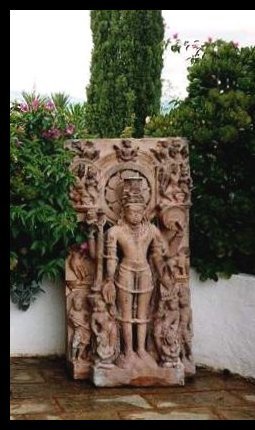VISHNU
India, Uttar Pradesh
9th/10th Century
Sandstone
Height 112 cm
A Central Indian buff sandstone stele of Vishnu, probably Uttar Pradesh, circa 9th/10th Century, standing in samapada and flanked by numerous swaying attendant figures, holding the lotus, mace, wheel and conch-shell in his four hands, and wearing a dhoti, floral garland, spiral armlets, necklace suspending leaf-shaped pendants, and faceted crown, the upper section with Brahma and consort, Uma-Maheshvara, and flying apsaras, faint traces of carmine of the surface.
Vishnu is one of the
principal gods of Hinduism; as preserver he is the embodiment of the
quality of mercy and goodness, the self-existent, all pervading power
which preserves and maintains the universe and the cosmic order
(dharma). To accomplish his task, he takes a number of incarnations,
which he sends to earth endowed with a spirit of self-sacrifice and
devotion. Varaha is Vishnu's third incarnation and is depicted at his
right, in the top corner; taking the form of a boar, a water loving
creature who creates the world out of the cosmic waters. The lion
avatar Narasimha is Vishnu's fourth incarnation, depicted at his left,
in the upper corner. His mission was to free the world from the
destruction caused by the demon King Hiranyakasipu who had obtained
from Brahma the boon of immunity from attacks by man, beast and god. In
the shape of Narasimha, half man and half lion, Vishnu succeeded in
destroying the demon.
Standing on a lotus throne, Vishnu is
surrounded by a number of devotees and animals, and flanked by his two
Saktis (female energy); Lakshmi the goddess of wealth and fortune and
Bhu-Devi, the mother of the earth. Vishnu's four hands represent his
fulfilment of manifestations in all forms of life; they represent the
four directions of space, the four stages of human development, and the
four aims of life- pleasure, success, righteousness, and liberation.
His lower right hand makes the gesture of varada mudra, the pose
conferring grace, charity and gift bestowing. The god's lower left hand
is holding a sankha, the symbol of the origin of the five cosmic
elements; with this conch shell he raises a deafening noise to terrify
 the enemy and to marshal his own forces. The gada or mace is the power
of knowledge; this long club is carried by the god as a weapon of
attack. The cakra is the symbol of the mind, a circular discus which
Vishnu hurled at his enemies to destroy them. He is adorned with a
karanda mukuta, ear ornaments, a necklace, bracelets. anklets,
ornaments and a jaynopavita, the holy Brahmical cord. At the top is a
depiction of garland bearing apsaras; they hold a protecting umbrella
above the god's head.
the enemy and to marshal his own forces. The gada or mace is the power
of knowledge; this long club is carried by the god as a weapon of
attack. The cakra is the symbol of the mind, a circular discus which
Vishnu hurled at his enemies to destroy them. He is adorned with a
karanda mukuta, ear ornaments, a necklace, bracelets. anklets,
ornaments and a jaynopavita, the holy Brahmical cord. At the top is a
depiction of garland bearing apsaras; they hold a protecting umbrella
above the god's head.
Carved out of fine sandstone, this work of
art is a good example for the mediaeval schools of sculpture during the
Chandella occupation. This ethnic group had a strong cultural,
political and imperial influence and ruled in central India from the
10th until the 12th century. Of the eighty-five temples constructed by
the Chandella kings, only twenty have survived, including the famous
temples of Khajuraho, to astonish the world with their unearthly beauty
and sensuality. Characteristics for this style are the construction of
the piece, the pronounced arched eyebrows, and the style of the
ornaments. The shape of the karanda mukuta and the proportions of the
central image are typical for the early Chandella style dating from the
10th century.
Vishnu is represented as a powerful and convincing
god with lively facial expression. His monumental appearance reveals a
restrained power and tension and contrasts beautifully with the
movements of the smaller images surrounding him. With striking
composition, fine detailing and deep relief carving, the piece can be
placed among the best examples known of its kind, reflecting its
iconographical meaning in a superb manner.
Provenance: Sotheby's, New York

|
 HOME
HOME

 the enemy and to marshal his own forces. The gada or mace is the power
of knowledge; this long club is carried by the god as a weapon of
attack. The cakra is the symbol of the mind, a circular discus which
Vishnu hurled at his enemies to destroy them. He is adorned with a
karanda mukuta, ear ornaments, a necklace, bracelets. anklets,
ornaments and a jaynopavita, the holy Brahmical cord. At the top is a
depiction of garland bearing apsaras; they hold a protecting umbrella
above the god's head.
the enemy and to marshal his own forces. The gada or mace is the power
of knowledge; this long club is carried by the god as a weapon of
attack. The cakra is the symbol of the mind, a circular discus which
Vishnu hurled at his enemies to destroy them. He is adorned with a
karanda mukuta, ear ornaments, a necklace, bracelets. anklets,
ornaments and a jaynopavita, the holy Brahmical cord. At the top is a
depiction of garland bearing apsaras; they hold a protecting umbrella
above the god's head.